It may seemed with all my previous Japan Travel Tuesday posts that we had a very cultural experience, but that’s not true. We also did quite a few miscellaneous fun things that were goofy. You may or may not want to also do these activities, depending on your own preferences. All these Japanese cafes and more are located in Tokyo. These were all fun for us, in their own special silly way. Some memories you make should not be serious.
Akihabara Maid Cafe
Visiting a Maid Cafe was not on my list of must dos, but apparently it was for F. He seemed to have a good time teasing me every time we passed by one of the maids on the street advertising their cafe, usually only a few steps away. We specifically stopped at an @home maid cafe location inside Don Quixote.
Maid Cafes are specific themed Japanese cafes where everyone is female, dressed like a maid, and serves you like you are a master or a princess (which is what they call you while you are there). No photos allowed at the cafe with the maids without paying, but after being on feet wandering Akihabara for hours since morning even before any stores were open, and now since it was well into lunchtime, we relished the chance to sit down purchased a lunch meal that included a photo for each of our meal packages (1 drink, 1 food dish, 1 photo) to look at and laugh at ourselves for years to come.
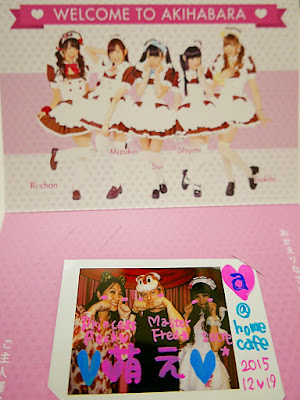
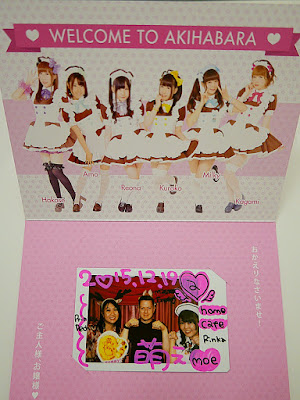
The food comes in the unique plating that can only be described as Cute Japanese Style Food. For instance, for his mocha latte and my green tea latte, we got to choose which animal we could have drawn on our beverage (I guess that explains the “Magic Sketch” portion of the menu item names). For my lunch I ordered the Cutie Puppy Curry Set that included little hamburger steaks for ears (hamburger steaks in Japan are a bit like salsbury steaks), and he got Napoletena Spaghetti Set. I don’t know why both sets came with potato salad. This was by no means a gourmet foodie meal… it was really just an unique experience as we had to awkwardly figure out how to sing with the maid waitress (you get to choose your maids from a bulletin board with their photos…) to add moe magic love filling to our food with a little song before we could eat :O

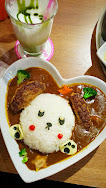

J World Tokyo and Namja Town
Also a request from F, who is more into anime than I am with his subscriptions to stream subtitled anime at Crunchyroll and FUNimation. He is more up to date on the latest series that are popular in Japan, particular with anime inspired by Shonen Jump, a weekly manga magazine that publishes the latest chapter of multiple manga series all in one anthology publication.
J World Tokyo is an indoor theme park focused on Shonen Jump manga characters like you see here, including both games and themed food that matches characters and scenes from the manga or anime. Some of the shows we saw featured included Dragonball Z, Naruto, One Piece, Gintama, Monster Hunter, Kuroka’s Basketball, and probably others that I don’t recognize.
The themed food was clever and in turns hilarious. Tip: when you pay admission, show your foreign passport to get a discount. On the website you can see that the games are pay per play, and which ones are marked with English translations available. With your admission, you come back as many times you you need to during the day, so we ate here for lunch on New Year’s Day and later came back for dessert after a dinner at Namja Town.

Namja Town is similarly is an indoor theme park focused also on Namja characters, games but also offering Gyoza (Potsticker) Stadium and several choices of dessert stands. Inside, it is themed like you are in a mini city even though you are just walking around part of the floor of a shopping center. There are even a few booths like this that you an get in and sit and eat like you are at home, and some area that evoke dining outside in a food court streetside with crates as part of the tables or your seats.
Gyoza Stadium is a food court area where you can order gyoza from multiple stands where each one has special unique takes on gyoza. Warning, this is not vegetarian friendly – most of the gyoza are filled with eat. Can you tell that the visit to Namja Town and Gyoza Stadium was my idea, not F? I think it was equal play – he got his J World and I got my Gyoza Stadium in Namja Town.
You can go to the counter of each gyoza stand and on the laminated menus there, look for one that is English so you can know what you are ordering. I recommend looking at them all to plan out which ones you want to try. They can bring you the gyoza in little boxes that you collect in a plastic basket so you can collect several boxes of gyoza to create your own gyoza buffet.
Also at Namja Town, you can also visit lots of various dessert stands where they plate the dessert in lots of cute ways, including with animal faces. When I went, they had some Sailormoon themed items, so I enjoyed a fruity beverage themed with Sailor Venus that included orange heart shaped fruit. One stand offered 50 flavors out of 88 possible ones for ice cream. We ordered a sorbet that had beautifu layers of color.
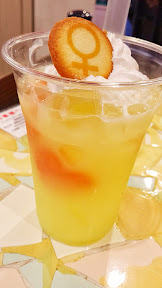
On New Year’s day a lot of things were closed, and if you are looking for an activity on a holiday, in the evening, or during crappy weather this might be also an option to consider as it is all indoors and they have a discount admission after 5 PM and are open year round. J World and Namja Town are both in the Sunshine City indoor mall in Ikebukuro, so you can also bolster your visit with shopping, eating, and they also offer in Sunshine City an aquarium, planetarium, movie theater, and a Pokemon Center.
Kanda Myojin
While we were in Akihabasa, we took a short few block walk away from the stores to visit Kanda Myojin, which some like CNN Travel call “The World’s Geekiest Temple”. This is due to a special good luck omamori (Japanese charm) available at Kanda Myojin, specifically an IT Charm to protect your technology devices. The charm you can purchase at this temple that is a 3 for one package that includes a credit card sized card for your wallet, a longer rectangular sticker for your computer, and a SD card sized sticker for your mobile phone.
The best information on Kanda Myojin I found was from the blog Rurousha who also mentioned that there was a tiny temple horse, and you can have your car blessed at the shrine. I didn’t see any car blessings in progress, but did see the horsie! I also found a fortune teller puppet machine.


For more information on omamori, which are great small souvenirs for yourself and to give others back home, and easy to get as they are available at all temples and shrines (though some specific ones like this one are at specific temples) see these two articles I found super useful.


Calico Cat Cafe
This was my request and F tagged along. There are multiple kinds of Japanese cafes that are animal themed in that they offer audience with a type of animal – ranging from cat cafes to owl cafes to goat cafe, rabbit cafe, even a hedgehog cafe. With the small spaces, long work hours, and often strict rules, many Japanese citizzens can’t own pets and so animal cafes are a way to get a little animal companionship. Although there is a cat cafe in Portland, it doesn’t offer as many cats as the ones in Japan do, and I wanted to try out the experience.
After finding the Calico Cat Cafe in Shinjuku in the 8th floor, we went to the welcome window where we’re given a time stamped lanyard. We will pay at the end based on how much time we spend in the cafe with the cats. You are given slippers to wear after you remove your shoes and place in lockers (there are more lockers inside past the door to the cats for your bags or anything else you want to put away). Then we wash and disinfect our hands at these sinks right before the door leading to the 2 floors of kitties, as illustrated here on the note on the mirror.


There is an area for cats to go away from humans and hang out behind a windowed area so you can at least admire them but can’t interact. You will find cats in cat beds, cat towers, and cat shelves 🙂
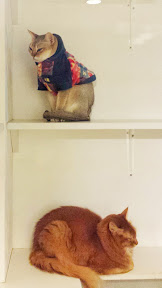



They have seats on the 2nd floor (take the stairs down from where you enter Calico Cat Cafe) but most people I saw just ended up settling at cat level on the floor. There are manga to read, as well as Wii and games to play. You can also purchase food and drink for yourself to eat at some of the seats downstairs. If the cat and human carer is not out you can ring the bell by the sliding window.


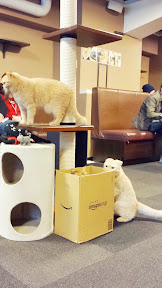

I highly recommend you spend the 300 yen for a little container of shredded chicken as cat treats, especially if you want to experience a kitty swarm as they all seem to know as soon as you crack the lid open a little bit. They KNOW. The Calico Cat Cafe staff will ask that you not feed the ones with scarves as they have a special diet you don’t want to ruin, and they will request you try to spread out the treats to different cats so no one gets too fat.

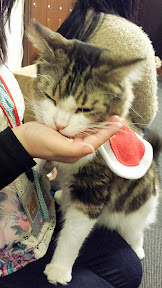
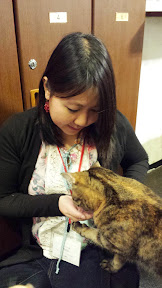
You pay by the first hour and then for every 15 minutes thereafter. There always seemed to be a “cashier cat” at the window – if one kitty leaves, another one jumped up there.


Ghibli Museum
F and I have seen all of Hayao Miyazaki’s films and are big Studio Ghibli fans, so purchasing a ticket to visit the Ghibli Museum was a treat for us. The museum works on advanced reservation tickets only that are open to be sold 3 months beforehand (and tickets do sell out!), and they are set for specific dates for one time admittance (no reentering after you leave). At the Ghibli museum’s entrance, the reserve tickets are exchanged for a 35mm film strip that features a scene from one of the Studio Ghibli films that you keep as a souvenir. I know the one to the left is from Laputa Castle in the Sky, but not sure what the right one is from.
You have to pay admission to go inside the museum, but some sights like the Totoro’s Reception window are outside the museum so you don’t necessarily need a ticket to see him.
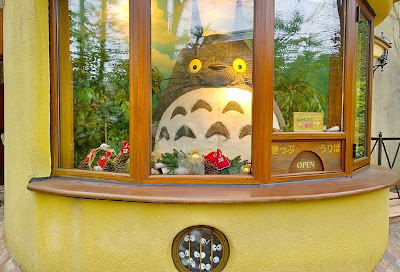
Ghibli Museum having all this green on it seems completely appropriate and expected since so much nature is part of the theme in the studio films and is part of the wonderful detail of the environment that they create in watercolor background for each movie. The museum has a Rooftop Garden at the top features a Robot from Laputa (Castle In The Sky), still tending to nature, and a symbol of humanity’s choice of whether its legacy will be as destroyers of this world or its caretakers.

I also knew that most of the exhibits were in Japanese, so we decided to go on a tour (we found one via Viator that was an afternoon tour). It sounds like the tour has changed since when we took it where the guide entered the museum with the group to explain some of the exhibits and walk through a couple rooms with us pointing out details that you might otherwise miss or and telling us the story behind some things and referencing the movie for us – otherwise we would have done a lot of looking but not necessarily a lot of understanding. Unless you can read Japanese I think a tour is invaluable in this case in giving you background and tips for the most enjoyment. The way the tour was set up she walked around pointing out extra stories or sights we might have missed, than gave us our own time to wander and we had a choice whether to leave with the group or stay longer.
Photos aren’t allowed inside the museum, so I only have photos from outside to share. Still, you can get an idea of the exquisite detail they have inside just from what I captured outside. I actually liked that no photos were allowed as it forced all visitors to get absorbed in the atmosphere and wonder. Hayao Miyazaki’s intention was that people focus on the experience and taking back memories. The information brochure even mentions “Those who can lose their way and fully enjoy this space are welcomed at the Museum.” The doors and all the windows and skylights featured breathtaking stained glass with references to the Ghibli films. Here’s a hint of that just from the front doors before I put away my camera, which pay homage to My Neighbor Totoro.
The Ghibli museum is 3 stories and is full of winding paths inside through little rooms and hallways, interior bridges and balconies, multiple winding spiral staircases including one in a small clock tower, to evoke a feeling of exploration and adventure. The building design is meant to be a nod to Hayao Miyazaki’s building designs in the Studio Ghibli films. When you visit Ghibli Museum, you get one entry to view a short film in the Saturn Theater, and the short film rotates and is original for the museum.
My favorite room was the history and science of animation that had a three-dimensional zoetrope of “Bouncing Totoro”, with models of characters from My Neighbor Totoro that it would stop moving so you can see all the detail of each individual figure, and then turn off the light and spin quickly to see the amazing animation as the characters come to life. It inspired Pixar to create one as well for California Adventure Land – this is the best hint I can give you at how truly fantastic it is.
Unfortunately, the plush cat bus upstairs from Totoro is for elementary kids only. The only other negative about the museum is that the gift shop is small and gets very crowded like a madhouse, so I would recommend visiting a Ghibli store elsewhere which will have similar products and more space, and there are several locations. Don’t miss visiting the cafe area where you can get a special Ghibli beer Kaze no Tani (you can take the empty bottle out with you), and check out the detail of the sinks with reference’s to Kiki’s Delivery Service.


Next week is my final Japan Travel post with a summary of the various types of Japanese foods to look for when you visit. Then, the Travel Tuesday posts will shift to Sante Fe!
Of all these various special interest stops, are there any that interest you? When you travel, are there certain types of “hobby or special interest” attractions that interest you? What do you think of the Ghibli Museum policy of no photos in order to have you absorb the experience and only take back memories instead of photos?
Here’s a summary of my Japan Travel post series:
- Guide to Planning a Trip: Research
- Guide to Planning a Trip: Mapping
- Hagoita Ichi Winter Festival at Sensoji Temple, Japan
- Japanese Treats at Temples and Shrines
- Winter Illuminations in Tokyo (Winter Season – November – February!)
- Snow Monkeys in Hot Springs
- Onsen by Mount Fuji covers Onsen 101 and how we loved our stay at Lake Kawaguchiko
- Dining at a Ryokan a look at what a traditional dinner and breakfast might be during a ryokan stay
- Visiting Cup Noodles Museum in Yokohama (just outside Tokyo)
- Visiting Shin Yokohama Ramen Museum
- Kyoto Temples and Shrines (walking tour starting in Higashimaya with stops especially at Kiyomizudera Temple, Kodaji Temple, Heian Shrine)
- Kyoto Temples in Arashiyama
- Kyoto Tofu
- Kyoto Famous Sights of the Kinkakuji (The Golden Pavilion) and Fushimi Inari (Red Torii Gates)
- Famous Signs of Osaka and eating Osaka Food specialities like okonomiyaki, takoyaki and kushikatsu
- Visiting Himeji Castle, the famous white castle in Japan
- Fun at Japanese Cafes and More including Maid Cafe, Cat Cafe; theme parks of J World and Namja Town, a geeky stop at Kanda Myojin, and Ghibli Museum
- Japan Eating Checklist is my top 25 list of things to try to include as an eating experience when visiting Japan
- New Year’s in Japan: Oji Fox Parade, and some photos of a Meiji Shrine visit on New Year’s Day









